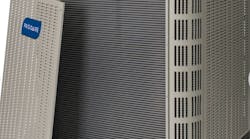As hydronic systems become more efficient, consumers are recognizing that they have a growing number of options to heat and cool their homes by pairing hydronics with other emerging technologies. Such hybrid systems can provide increased comfort and energy savings to this savvy homeowner population that knows there are a multitude of options available to them. So the questions for HVACR distributors and their customers are these: Are they staying up-to-date on these new products? Can they deliver what homeowners want?
Hydronics has certainly come a long way. Over the past decade, hydronic systems have emerged as some of the most efficient in the market, achieving efficiency ratings of 95 percent or above. Modulating gas technologies — whether it is a tankless water heater or modulating gas boiler — operate with more finesse, reducing temperature fluctuations, and providing a comfortable and consistent temperature that is quiet and efficient. Moreover, consumers perceive these new products as being much more accessible. It is one of the fastest growing segments of the market and even consumers living in row homes find them to be an attractive solution.
High-efficiency systems got a tremendous boost last year as consumers were eager to take advantage of federal tax credits. That was huge, says Jeff Thompson, product manager of Lebanon, PA-based APR Supply, because the credits helped level the playing field. As contractors promoted the federal tax credits, consumers began to embrace these new products and were willing to spend a bit more, especially when it would lead to long-lasting energy savings.
While there is a greatly reduced tax credit, known as 25C, for 2011 (the maximum tax credit cap was reduced this year from $1,500 to $500), Thompson still expects there to be continued consumer interest, although the momentum will slow. “In my opinion, it won't be at the same pace, but consumers are more aware,” he says. “Contractors have become better educated, and consumers are more educated about these new and better products that are available.”
Under the 2011 25C extension, hot water boilers, including natural gas, propane, oil furnaces and oil boilers, and natural gas furnaces and propane furnaces must achieve 95 percent efficiency. The boilers are efficient because the water absorbs heat from the flame so well that latent heat is removed from combustion gases utilizing all of the available heat.
With the addition of energy-efficient pumps that move water more efficiently through the home, homeowners have the added advantage of putting the heat where and when they want it. Additionally, outdoor reset controls allow for automatic temperature adjustments to match outdoor conditions — on warmer days, the boilers use a lower water temperature to meet household demands; on colder days, the boiler increases the water temperature to meet increased demands.
“There are plenty of choices,” says Thompson, who is also vice chair of HARDI's HVAC Systems & Equipment Council. “Every boiler manufacturer has a condensing gas boiler, and you're starting to see some newer products coming from manufacturers where you're getting 90 percent and above on oil boilers.”
In fact, hybrid systems are growing in popularity among homeowners, particularly systems that incorporate radiant heating. For APR Supply, radiant continues to be a growing market. “The reason is its flexibility,” Thompson notes. “You can do hybrid systems when you have a boiler and a separate air conditioner with an air handling unit and water coil off of that same boiler.” Some contractors are developing whole home radiant heating for floors in the kitchens and bathrooms.
Some units have built-in domestic hot water in the boiler, he says. With most of these, you have to pipe the water to an indirect water heater, but Thompson notes that you're still achieving efficiencies from that boiler.
Page 2 of 2
The key to selling these new, highly efficient systems is educating customers. Ed Howell, APR Supply's technical service and training manager, is the point man in the company's efforts to train its contractor customers on new technologies, including modulating gas technologies. Led by Howell, APR Supply has a strong technical staff, called the Technical Service Advisor Group, which is spread out among its 24 branches in eastern Pennsylvania. “We feel that the contractor needs some additional technical assistance because of the new modulating gas technologies and the variable refrigerant volume technologies and geothermal,” Thompson says.
While manufacturers offer technical support for their products, Howell points out that they don't provide support to the system their product is connected to. With its technical expertise, APR Supply can often pinpoint and solve tricky problems that may be in the duct system, for example. “Our main goal is to find out where the problem exists,” Howell says. “Is it in the air flow system or the hydronic system? We get involved and ask the right questions.”
It's clear that customers want to stay on top of these new technologies. Thompson recalls two seminars hosted by APR Supply that occurred this year on a snowy winter day in which one manufacturer conducted a training session in the morning on condensing oil and, that afternoon, focused on modulating gas technology. Both seminars were filled to capacity.
In May, Howell will conduct a training session at the National Association of Oil Heat Service Managers' annual trade show in Hershey, PA. “Oil is slowly fading, but if they can integrate hybrid systems, that may reverse that trend. Maybe they can turn that around by utilizing hybrid systems,” Thompson says.
As hybrid technologies become more popular, they offer fuel choices, higher efficiencies, greater comfort and a good return on investment, with most of the installations occurring in the custom home and higher-end retrofit market. “In the custom home market, you could absolutely see these new types of hybrids with the resurgence of hydronics because of the increased comfort level,” Thompson says.
Geothermal is another technology that continues to gain traction as federal tax credits for the installation of geothermal and solar installations become better known among consumers and contractors. “We're betting on geothermal being a really big deal and gaining momentum between now and 2016,” he says of the federal tax credits, known as 25D, for the installation of residential geothermal and solar systems.
There are any number of possibilities for distributors and contractors, from air-to-air systems, water-to-air and water-to-water systems as well. Thompson sees the possibility of geothermal water-to-water systems with hydronic air and radiant floor heat. “We can take the geothermal water on the heating cycle and use it for radiant heat or warm floor for kitchen and bathrooms,” Howell says. “On the cooling cycle, we can take the chilled water to a coil connected to a duct system for air conditioning. The duct system gives heating and cooling through the geothermal system.”
Comfort is the name of the game for homeowners. When you can offer efficient systems that bring together some of the old (hydronics) and new (radiant, geothermal) technologies for consumers who are willing to pay for them, you're giving them the green they're looking for while making it profitable for yourself and your customers.
Michael Maynard is a business writer based in Providence, RI, who writes on issues related to HVACR, construction and architecture. Contact him at [email protected].






